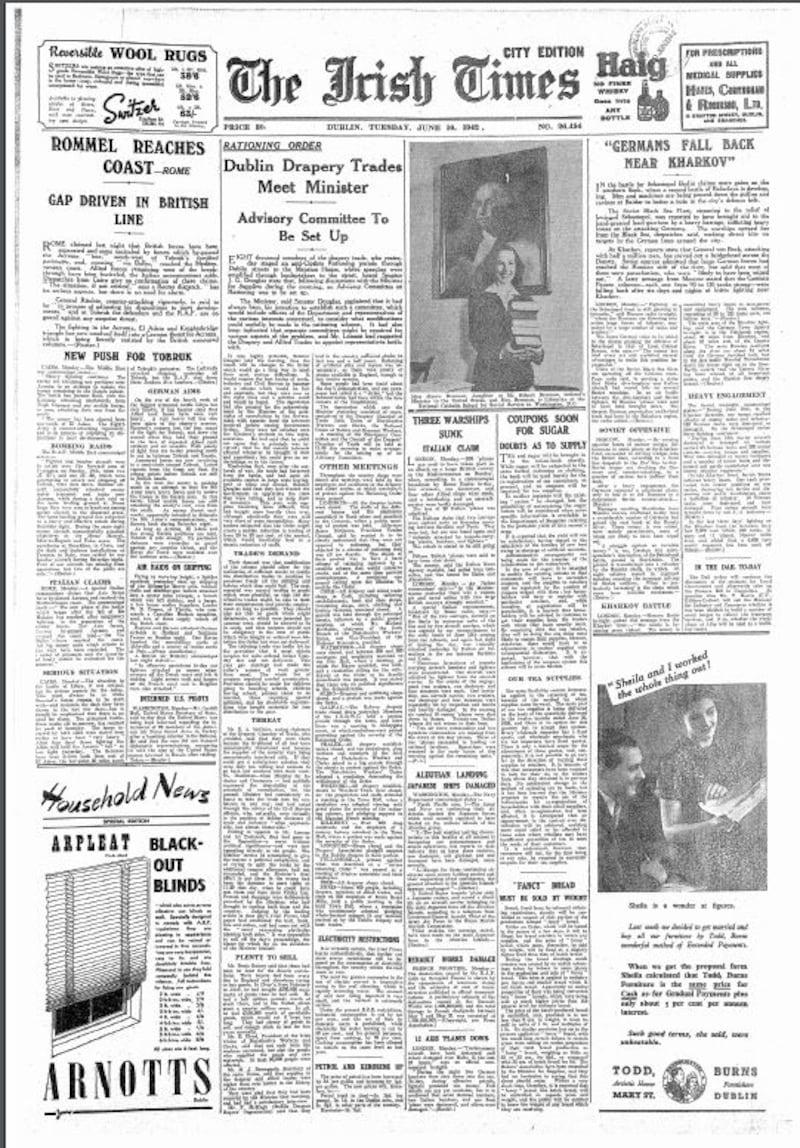June 16, 1942
With fears that Brexit will potentially lead to shortages in medicine and food in the UK, it’s worth taking a trip back to Ireland in the 1940s to see how bad rationing was.
On Tuesday, June 16th, 1942, details of an extraordinary national protest were reported on the front page of The Irish Times. The protestors were members of the drapery trade, and allied trades, furious about the wartime rationing order on clothes. In Dublin, 8,000 members of the drapery trade marched through the city and on to the Mansion House, where speeches were delivered. The workers were objecting to rationing that they believed to be too drastic, and called instead for a scheme to be in place that conserved stocks and prevented unemployment.
The protest was replicated in cities and towns around the country. In Limerick, all drapery houses were closed, with the staff of different houses marching to the Crescent, where a public meeting was held. In Cork, all drapery and allied trade shops closed, including tailors, boot and shoe shops, and shirt, clothing and hosiery factories. Workers marched through the streets and then held a public meeting. In Waterford, all drapers shops were closed, and between 200 and 300 workers marched to City Hall.
In Sligo, shops also closed. In Galway, all drapers were closed, and a meeting was held in Abbeygate Street. In Tralee, all drapery establishments closed, and a march was held. The same was true for Waterford, and a meeting held in the Town Hall. In Kilkenny, 400 shop assistants and the employees of a hosiery factory marched to the Town Hall. In Longford, shops closed. In Tullamore another protest was held. In Birr the drapery shops closed, and in Ennis around 400 more drapers and members of allied trades along with 200 employees of the Ennis Braid Mills held a meeting in the Town Hall.
Second World War
Upon the outbreak of the second World War, “the trade had borrowed from the banks, and had sunk all available capital in large scale buying, both at home and abroad,” the reporter wrote, paraphrasing Senator JG Douglas, who was bringing news to the Mansion House meeting that the Minister for Supplies was going to establish an Advisory Committee on Rationing to consider modifications to the rationing order. As supplies became more difficult to source in wartime, the drapery trade had to spend more money, and were concerned that the rationing order could reduce their trade by 20 to 30 per cent.
“The tailoring trade was badly hit by the provision that it must obtain coupons for suits ordered before Tuesday last and not delivered,” the report read, “This year gas shortage had made the tailor’s arrears of work greater than usual.”
Immediately following the report on the drapery industry demonstrations, was more dour news about other shortages. “It is virtually certain, The Irish Times learns authoritatively, that further and more severe restrictions will be imposed on the consumption of electricity throughout the country within the next week or two,” the report read.

“The need for greater economies in the use of electric current is imperative owing to the coal situation, which is rapidly becoming worse. The amount of coal now being imported is very small, and the outlook is extremely serious.”
‘Fancy’ bread
By this stage of the war, industrial consumption of electricity in Ireland had been restricted by ESB, amounting to a cut of ten per cent. The use of fires in homes was prohibited, and electricity for water heating had been cut by 50 per cent, and for other general purposes - besides cooking - by 25 per cent.
Elsewhere on the front page, there was further rationing news. “Tea and sugar will be brought in to the ration-book shortly,” the report read, “While sugar will be subjected to the same formal rationing as clothing, the book will be used merely for the re-registration of tea consumers, at present, and no coupons will be required for tea supplies.” Issues with rationing sugar revolved around concerns in 1942 that the yield of the sugar beet crop would be down, as farmers were reluctant to sow it due to a shortage of artificial manures.
A report below that one, detailed a particular type of bread rationing. “Bread, freed from its informal rationing restrictions, shortly will be controlled in respect of that portion of the production termed ‘fancy’ bread… During the bread shortage much concern was caused by an unfair advantage taken by bakers in some places in the production and sale of ‘fancy’ bread.”
The price of batch bread had been controlled, and sold in units weighing 1lb and multiples of 1lb. However, some bakers were making a disproportionate amount of lighter, “fancy” bread and selling it at a higher price. The Minister for Supplies made a decision, therefore, that the price would be controlled and based on weight. Tight times indeed.








